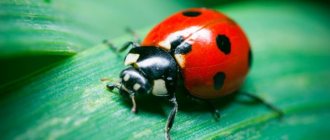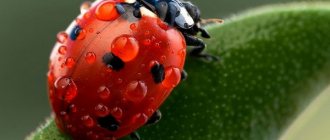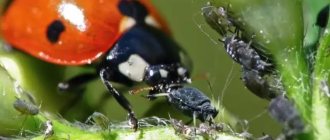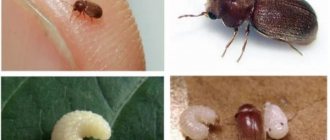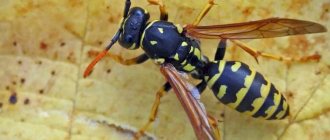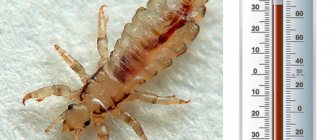A child ate a ladybug - what to do?
Most people associate the ladybug with something cute and harmless, but it is not for nothing that nature created it bright and colorful. For insectivorous birds, this is a kind of signal that warns that this species should not be eaten. When in danger, the ladybug secretes a very poisonous hemolymph of bright orange color. However, small children, on the other hand, are attracted to everything bright, and it is difficult to resist sucking the beetle they like into their mouths.
If a small child has eaten a ladybug, the first priority is to calm him down and convince him that nothing bad happened. Some parents become nervous and only intimidate the baby. Some even suggest inducing vomiting, but this is absolutely unnecessary stress - it is better to just let the child drink a glass of water. Drinking will speed up the movement of the beetle into the stomach and provide an additional calming effect. If a child is bothered by a bitter feeling in the mouth, the mouth should be rinsed thoroughly. Some children complain of slight nausea - in most cases this is the effect of psychosomatic factors. In order for intoxication to begin, you need to eat a large number of insects. You should calm the child down by any means accepted in the family, give him activated charcoal and convince him that everything will pass soon. If the child feels well and is not worried about what happened, you can simply laugh and forget about what happened.
Some parents are worried that some kind of infection could get into the mouth along with the insect - this option cannot be ruled out. Insects can crawl anywhere, including through dirt, but in this case you will have to deal with ordinary food poisoning, which has nothing to do with the toxicity of the ladybug.
A cat or dog ate a ladybug - what will happen?
Playful pets often show interest in insects: they chase butterflies, flies, and cockroaches. A small ladybug is also suitable for a fun game. If during such a game a dog or cat ate a ladybug, it is worth watching them. The poison secreted by insects can cause quite severe irritation to the animal’s oral cavity. In this case, the pet will show signs of anxiety: turning its head, sneezing, sticking out its tongue. There may be excessive salivation. Don’t be alarmed by these symptoms—the animal just needs to rinse its mouth with plain water. This can be done using a syringe or a syringe without a needle. After a few hours, the feeling of bitterness in the mouth will pass.
There's a ladybug at home - what to feed it?
If you find a live ladybug in your apartment, help it survive until spring. The best way is to take it out of the house, but not to throw it into the snow, but to find a good shelter. A barn or garage is ideal for this purpose, where they can overwinter without any problems. Do not do this in severe frost, so that the temperature difference for the insect is not too strong.
If you want to try to keep a ladybug alive at home, you need to know what to feed it and how to properly maintain it. Take any container, arrange a floor at its bottom from leaves, branches, sticks and transfer the ladybug there. We also recommend that in order to create optimal living conditions for the insect, put more straw and dry leaves into the container, loosely mixing them together, so that artificial crevices are created, which ladybugs so love to use as their lair. It is possible to use corn tops for shelter in a jar; it will perfectly close the insect’s home from prying eyes. At home, ladybugs are fed with sweet sugar water or honey; you can pour these mixtures into the cap of a plastic bottle. This food is a treat for the ladybug. In addition to sweet water, these beetles are fed raisins and pieces of ripe apples. Just like any pet, a ladybug needs some water.
Can this insect bite or not?
Of the large number of varieties of ladybugs, and there are more than 5,200 species, only a couple of species bite and are dangerous to humans, for example, Harlequin and with 28 spots. They can bite hard and cause harm to the body.
Other species only pinch prey with their claws in case of attack or defense. The ladybug secretes a special yellow secretion from the joints of its legs, which is poison for most insects. It smells sharp, tastes bitter, and can scare off the main enemies:
- frog;
- insects that feed on cows;
- spiders
Birds also try to avoid it because of its unpleasant taste.
The onset of winter forces the insect to prepare for hibernation. The cow stores nutrients and removes excess water from its body. At this time, from the end of September, it becomes as aggressive as possible and can even attack a person.
Description of the insect
Surprisingly, about 5 thousand species of these bugs live throughout the globe . True, in the European part there are only 100. Insects love warmth, so they are active only in warm weather, and when it is cold, they fly less and do it much more slowly.
There is an opinion that the number of black dots on the body of a ladybug indicates the age of the insect - this is not so. Rather, from these points you can understand what species the bug belongs to.
A ladybug can be more than just red or orange. The ten-spotted ladybug has a dark brown color, the fourteen-spotted ladybird is yellow, the dotted ladybird is completely black, and the streaked ladybird is black with a yellow speck. There are representatives of the species that are very easy to confuse with other beetles. Moreover, not all of them are smooth; there are even very furry species of insects, which is unusual for us.
Read also: Instructions for using Gamavit for rabbits
If you touch a ladybug, it will secrete a yellow substance with an unpleasant odor - this is a defensive moment that allows you to scare away creatures that are dangerous to the insect.
How dangerous is the bite, is it poisonous to humans?
While playing with a ladybug in your palm, pay attention to its color. An ordinary red little cow with 7 spots is not dangerous to humans. But with 28 spots or black with red dots, a Harlequin can bite quite painfully and with consequences.
An ordinary cow, pinching a person and releasing its juice, can provoke a slight tingling of the skin, which is not dangerous for most. But after being bitten by a 28-spotted one, you will have to seek help from a medical facility.
The ladybug does not feed on human blood, so it cannot become a carrier of diseases for him, like a mosquito.
The big danger lies in the secretion released from the joints. This is the hemolymph of an insect, containing two alkaloids:
Do ladybugs bite and are they dangerous to humans?
Do ladybugs bite?
Most ladybugs do not bite, but can use their jaws to pinch for protection. Ladybugs eat caterpillars, aphids, slugs, snails, spider mites and the larvae of various insect pests, so they can be called predators.
When cold weather sets in, they prepare for hibernation, stocking up on nutrients and removing water from the body. It is during this period - at the end of autumn, that they are capable of aggression, like any living creature on the planet, sensing the danger of destruction when it is angry (especially during the period of preparation for hibernation) - a cow can pinch a person, but the bite is not dangerous.
Some ladybirds, such as the 28-spotted ladybird and the Harlequin ladybird, are capable of more powerful attacks on humans.
If ordinary ladybugs do not harm humans, but rather even benefit them by eating pests and clearing plants of unnecessary accumulations of insects that can destroy them, then these two species, on the contrary, eat plants in gardens and forests and cause harm. The 28-spotted ladybug is found in the Northern part, and the Harlequin in the Asian part.
For example, Harlequin loves shady areas and where there is a lot of greenery, forests, parks, and cottages. And the ladybug with 28 spots prefers bright areas: vegetable gardens, summer cottages, farms, private houses. Where vegetables, herbs, fruits, and berries are grown.
They eat leaves of potatoes, cabbage, radishes, carrots, beets, etc., which sometimes causes severe damage to the crop. Northerners know that such a ladybug can bite quite hard, like a midge or even a mosquito. But, unlike these flying insects, ladybugs do not feed on blood!
How dangerous is a ladybug bite for humans?
So, we figured out which ladybugs can bite painfully - 28 spots and Harlequin. No cases of bites have been recorded among other ladybugs.
Only an imperceptible and even almost imperceptible pinch of the skin is possible, which a person will not even notice. What to do to avoid a ladybug bite: do not pick up unfamiliar insects in your hands, but it is better not to touch the insects at all.
What is the difference between the 28-spotted ladybug and the usual harmless one - the spots, they are small and there are a lot of them. The harlequin is a large ladybug, the head is searing black with bright white spots, and a bright orange or pale yellow color is visible on its wings. The main difference is white spots on the head and large, uneven black spots on the wings.
Harlequin ladybug - why is its bite dangerous?
Such individuals are “predators”; they, of course, do not feed on blood, but are able to reproduce quickly and a lot, settle in convenient places closer to humans and cause a lot of unpleasant trouble. When bitten, you may experience:
- redness on the skin;
- itching;
- swelling;
- edema;
- allergic reaction.
Description and photo of the most dangerous black species of Harlequin
Let's look at what makes the black Harlequin cow special and dangerous. Another name for the breed is the Asian ladybug. Because of their gluttony, the first insects were brought to the countries of America and Europe from Asia to control pests in greenhouses, since the Harlequin eats up to 200 aphids per day.
But scientists were unable to control the insects. This species is rapidly multiplying throughout the planet, adapting at the expense of local cows and destroying its relatives.
She loves shady places with a lot of greenery, trees, and bushes. The body of the Asian Harlequin can be attacked by parasites and mites. Therefore, this species is a carrier of diseases and poses a threat to other insects and people.
Harlequin causes irreparable harm to a person. Settling in a summer cottage or garden, the insect eats the foliage of radishes, beets, cabbage, potatoes, and garden trees. An invasion of ladybugs can completely destroy a crop in a few days.
You can distinguish it from a mosquito by several characteristics:
- the poison irritates the skin, the bite site turns red;
- there is a strong feeling of itching;
- the skin becomes swollen and swells;
- an allergic reaction occurs.
To avoid being bitten, it is not recommended to handle unknown species of ladybugs.
Next you can see what a black Harlequin looks like:
Video about interesting facts and features of the Asian ladybug:
How to properly treat a bitten area?
If you receive a bite or slight tingling from a cow, be sure to treat the area with special antiseptic agents. It can be:
- any cream for mosquito bites;
- chamomile decoction (pour 1 tbsp of chamomile flowers with a glass of boiling water);
- plantain decoction (50 g of leaves, pour 250 ml of water and boil).
It is also necessary to apply antiallergic ointment, for example:
If an allergic reaction occurs on the skin, be sure to take an antiallergic drug, for example, Loratadine. This will help avoid swelling.
If you feel nausea, vomiting, or the bite site is very swollen, consult a doctor immediately!
It is also recommended to cover the bite site with clothing or a sterile bandage.
This will prevent scratching and infection in the wound. Treat it daily with hydrogen peroxide and lubricate it with antiallergic ointment. If you still get an infection, you must use:
- anti-inflammatory ointments;
- brilliant green;
- fucorcin.
A sudden invasion of ladybugs indoors or in the garden also needs to be actively combated. At home you can use:
- dichlorvos;
- sticky fly tape;
- mosquito sprayer;
- pencil-chalk “Mashenka”.
The story of an injured bodybuilder
To understand how dangerous a ladybug bite is, you can read the story of the famous bodybuilder Rez Rezamand. At the age of 31, he went to the hospital in serious condition.
The doctors barely had time to provide him with immediate assistance. The fact is that he was bitten on the leg by a small ladybug, to which the athlete did not even pay attention. A few days later, Reza could no longer walk; his leg and fingers were swollen to incredible sizes! The wound from the bite became infected, the leg began to turn black, and sepsis began. After long days of therapy with strong antibiotics, doctors managed to save the athlete’s life and leg.
Will you get poisoned by eating a ladybug?
Have you noticed that most insects hide in the ground, under leaves or stones, while a ladybug can quietly bask in the sun? The answer lies in its bright coloring, thanks to which nature often marks insects that are not worth messing with. However, man is a strange animal, how many times have you taken a ladybug and launched it into the sky? You are attracted by its beauty, even despite the fact that many people know about its toxicity.
Why is a ladybug dangerous?
Have you ever noticed why most insects hide in the ground, under leaves, grass and stones, while a ladybug can quietly bask in the sun? The answer lies in its bright and variegated coloring, thanks to which nature itself explained to all surrounding predators that it is better not to mess with it. However, man is a rather strange animal, how many times have you launched a ladybug into the sky? We are attracted by the beauty of this beetle, even though many people know that it is poisonous.
Why does a ladybug land on a person?
Sometimes a pleasant event occurs that predicts good luck in various areas of life. If a ladybug lands on you, the omen takes on different meanings depending on where exactly the charming bug ends up.
On your head
Signs say that a bright insect on the forehead is a good sign for work. A career take-off, a positive outcome from an unpleasant situation in the work team, and rapid development of your own business are expected.
Any difficulties are now easily overcome, and ill-wishers are not scary. The main thing is not to brush the “messenger of good luck” to the ground in fear, so that success does not pass you by
It is important in which zone the bug is located:
- Signs promise a meeting with true love for people who have had a ladybug land on their face. They will receive the desired new impressions, or established relationships will shine with new colors.
- A cute insect on the top of the head portends an interesting job for a manager, a higher step on the career ladder, or the acquisition of people management skills.
- A bug lost in the hair is a signal for a businessman: you can actively develop your entrepreneurial activity.
Don’t scare the “guest”, put your hand up - the bug will crawl onto your fingers, and from there it can “start” upward.
On hand
If a ladybug sits on your right hand, pleasant events await you (your cherished wish will come true), if on your left forearm, changes will affect the most valuable area of life - health (it will noticeably improve).
Another version of the interpretation of the sign. The hand is a human organ that is associated with making a profit (“hold in hands”, “give in hands” and the like).
On the other hand, most things are done with hands, so this part of the human body symbolizes success in all endeavors. Therefore, if a ladybug sits on the left hand, this portends good luck in the field of finance, if the bug is located on the right palm, this guarantees the successful completion of any projects.
With the help of a ladybug landing on your hand, you can tell fortunes:
- Ask about your concerns and gently blow under the beetle's wings. If it takes off immediately, it means that the problem will not be solved for long. If the “guest” remains sitting on the hand, then the wish will not come true, or its fulfillment will take a while.
- You can guess the weather in the same way. If the little red bug doesn’t take off from your palm for a long time, it means it’s raining; it leaves immediately – clear weather is expected.
- For the girl, the little messenger of the gods will predict where to expect her betrothed. To do this, before blowing on the bug, you need to ask it to show the direction. And when the insect takes off, watch its flight. In which direction the ladybug goes, matchmakers will have to wait from there. If the red bug remains sitting on the palm, you can’t count on marriage in the near future.
- If a girl holds a ladybug in her closed fist (so as not to crush or damage the insect), and then opens her palm, the behavior of the bug will show her betrothed. If the insect flies literally vertically upward, then the groom may be standing nearby.
- If a ladybug lands on your upper limb, you can ask her for help in finding mutual love. Is the insect already on your hand? Count to 22. If the insect does not fly up before the count is completed, a decent life and happy love awaits you.
By holding the messenger of heaven on her hand for a longer time, the girl can count on the bug to give her the power with which she can quickly find her groom.
A ladybug on the shoulder foreshadows joyful events, for example, a meeting with a friend or help from a person who was not previously considered close (the shoulder symbolizes friendly support).
Folk omens categorically do not recommend shaking off God’s creation with your second hand (this way you can brush off your luck with your own hands).
Folk signs categorically do not recommend shaking off God’s creation with your second hand
To make your wish come true, according to the signs, you need to raise your finger up (the insect will reach the highest point and fly away). Another option is to carefully transplant the bug onto a high branch.
On the body
It happens that a ladybug sits on the head and then moves through clothes or various parts of the body. In such a situation, signs promise different events depending on the place where the insect is located:
- On the chest - soon you will find your soul mate. Happiness in love is guaranteed.
- On the back - a speedy resolution of long-standing problems.
- On the leg - quickly achieving your goals (if the bug crawled to the end of the leg). If the insect stops in the middle of the limb, you should not expect quick changes.
If a bug just crawls on your clothes, you can expect a pleasant surprise from a loved one. You may receive a present.
Why is a ladybug dangerous?
The first thing you need to know is that in case of danger, ladybugs have an effective method of protection. This is a poisonous, sharp-smelling yellow liquid that ladybugs secrete from the joints of their legs. With the help of this liquid, ladybugs scare away their enemies - frogs, spiders and many insects. Birds and other animals completely avoid ladybugs.
What is this yellow stuff?
The very feeling of danger causes ladybugs to secrete droplets of yellow hemolymph from their joints, which have a nasty taste to humans. The bitterness of the hemolymph of ladybugs is imparted by adalene alkaloids.
Why is a ladybug useful and how to attract it to the garden?
The ladybug is one of the few insects that people, especially children, like. Everyone probably remembers the children's song: “Ladybug, fly away to heaven...” Once upon a time in childhood, we caught these bugs and always released them, throwing them up and singing these words.
Ladybug
It’s not for nothing that the epithet is God’s. In almost all countries the name of this insect is equally poetic. For example, Catholics call it ladybird, ladybug. The word Lady in this context implies the Virgin Mary, that is, the ladybug is considered the insect of the Mother of God.
In France it goes by the name poulette à Dieu (“god’s chicken”), in other countries its name is also associated with a pet belonging to God. This bug cannot be confused with any other: the black dots on the bright red or yellow back immediately catch the eye. Today we will learn more about these seemingly familiar, but essentially little-known insects.
Read also: Varieties of white rabbits
Ladybug, fly to heaven
